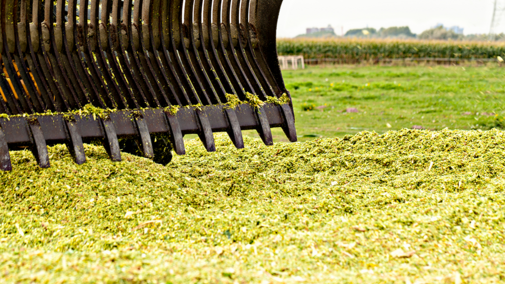Inoculants for Corn Silage
Corn silage harvest success rests on proper harvest, packing and storage practices. When we need a boost, adding an inoculant at harvest time can help improve fermentation and storage, but we need to know what products to use to get the best result.
Silage inoculants are simply bacterial cultures that help manage pH in the pile by converting sugars to acids which reduce molds, fungi and unwanted bacteria such as clostridia.
When selecting an inoculant, the first step is deciding if upfront fermentation or pile stability are needed, or maybe both. Upfront fermentation helps if most of our issues center around harvest and packing. If problems are more centered on storage and feed out, stability is where we should spend our money. Sometimes, a mix of both is needed.
Inoculants primarily reduce storage losses. Silages that contain homolactic acid bacteria such as Lactobacillus plantarum help fermentation start and end quicker by dropping the pH fast. This allows more silage to remain for feeding. Other inoculants, like heterolactic acid bacteria Lactobacillius buchneri, can improve aerobic stability by reducing spoilage losses when silage is re-exposed to air. These bacteria are especially useful at reducing spoilage on the face of bunker silos if the face is too wide to keep fresh or if producers take out several days’ worth of feed from the pile at one time.
The purpose of inoculants is not to fix a train wreck or improve a perfect silage year, but they can help when things aren’t ideal. Inoculants can be used as an insurance policy to reduce the risk of spoilage and maintain quality.
Verbal Pasture Lease Agreements
There are a couple of leasing options for producers and landowners. Verbal leases are a common form of lease agreement. However, if someone is considering terminating a verbal lease, there are some dates and rules to remember for those with crops vs. pasture verbal lease agreements. The Nebraska Supreme Court has ruled that the lease year begins March 1 for year-to-year verbal leases. Notice to a tenant to vacate under a verbal or handshake year-to-year lease must be given six months before the end of the lease or no later than Sept. 1 for crop production. It is recommended that Registered Mail™ terminate the farmland lease. This means the person receiving the letter signs for it, providing evidence that the termination notice was received.
Handshake or verbal leases are different for pastures. The typical pasture lease is for the five-month grazing season. The lease is only in effect for that time, so the lease is terminated at the end of the grazing season. However, different lease length arrangements can be made in a written lease.
In all instances, written leases would be preferred over oral or “handshake” leases. Sample leases are available in the Ag Lease 101 library and can help both parties start thinking about the appropriate lease conditions for their situation.
Storing Silage
Corn silage harvest may seem like a long way off, but preparation for a successful harvest begins now. Improper silage storage and fermentation can result in losses up to 20% prior to feeding. Plan your storage now to keep excessive storage losses from happening to you.
Preventing oxygen from entering your silage should be a top priority when considering silage storage. Bagged silage is a versatile option that allows the storage location to move year to year and comes with a built-in oxygen barrier but can carry a high price tag and may not be appropriate for large harvest amounts. Placing the silage in a bunker is another that can increase oxygen exclusion, but make sure to check these structures for cracks and repair any that are found to maintain their integrity. If silage is a feedstuff on your operation, the reduction in losses that a permanent structure paired with covering the pile provides can offset the costs when spread out over several years.
Silage piles are the more traditional approach and can allow for greater volumes of silage to be stored in a smaller area without the cost and permanent nature of bunkers. Oxygen exclusion in piles that lack a permanent structure can be enhanced with some planning. Before harvesting, line the sides with bales and place oxygen-limiting plastic down the sides and for several feet under the bottom to seal the sides of the pile. At a minimum, placing plastic on top of the pile is an investment worth the time, labor and money. By covering the pile, we can reduce oxygen from moving into the pile from the top and reduce precipitation exposure.
Corn silage is a valuable feed resource and keeping oxygen out of your silage requires planning now. Pick an appropriate location for harvest and feedout success, and store correctly to minimize feed losses.

